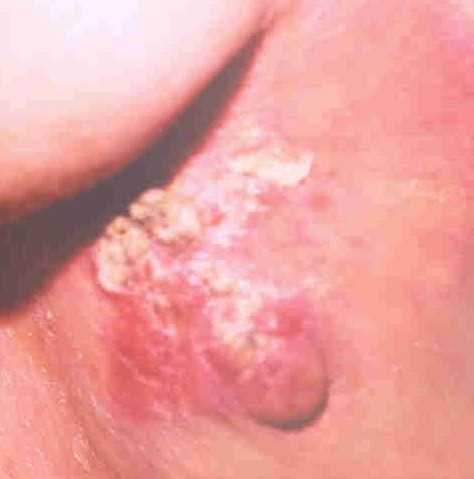
A woman with locally advanced breast cancer.
The traditional way to assess a breast lump is to take a history, do a physical examination, do a fine needle aspiration cytology (examination of a breast lump aspirate under a microscope), mammogram and/or ultrasound, core biopsy under ultrasound control and finally, if there is no satisfactory answer then do a surgical biopsy.
A surgical biopsy gives us a definitive answer. But there are drawbacks to sending every patient with a breast lump for surgery. To start with it causes severe anxiety. You have to take a day off work. It requires local or general anaesthetic. There may or may not be postoperative complications like bleeding, bruising, discomfort, infection and pain.
On a long term basis, surgical biopsy will leave you with a scar and may be another lump which may be just a scar tissue but could be suspicious for cancer. Then you have to go through the whole process all over again.
Is there anything else we can do before going for surgery to make sure that there is no cancer in the breast?
You can ask for a second opinion. If all investigations are negative then there is a less than five per cent chance that cancer has been missed. In that case, we can leave the lump alone and provide follow up care with clinical examination and mammography or ultrasound, on a case by case basis. Sometimes a patient will ask for MRI.
MRI (magnetic resonance imaging) is a procedure that uses a magnet, radio waves, and a computer to make a series of detailed pictures of areas inside the body. MRI does not use any x-rays.
MRI is not available for routine screening. It is expensive and requires specialized equipment and personnel with good solid training to read the images. Hence, it is available in bigger cities only and is not covered by government insurance plans. MRI is more often used for breast imaging in the US than Canada because of the prevalence of private health care.
MRI is sensitive to small abnormalities in breast tissue. MRI also has limitations. For example, MRI cannot detect the presence of calcium deposits, which can be identified by mammography and may be a sign of cancer.
The value of breast MRI for breast cancer detection remains uncertain. And even at its best, MRI produces many uncertain findings. Some radiologists call these “unidentified bright objects,” or UBOs.
In women with a high inherited risk of breast cancer, screening trials of MRI breast scans have shown that MRI is more sensitive than mammography for finding breast tumors. Screening studies are ongoing.
Breast MRI is not recommended as a routine screening tool for breast cancer. However, for women at high risk, women with previous breast cancer, MRI can be useful in certain circumstances.
Start reading the preview of my book A Doctor's Journey for free on Amazon. Available on Kindle for $2.99!

Hello Dr. Bharwani. I have been a patient of yours several times and read your MH News
articles. I have a suggestion regarding an article that could poitentially save many lives.
Inflammatory breast cancer is virtually unknown to most, if not all, of my female friends
and yet, although rare, does occur. My suggestion is that you devote an article to this
subject describing the related symptoms…………….Gordon Briosi